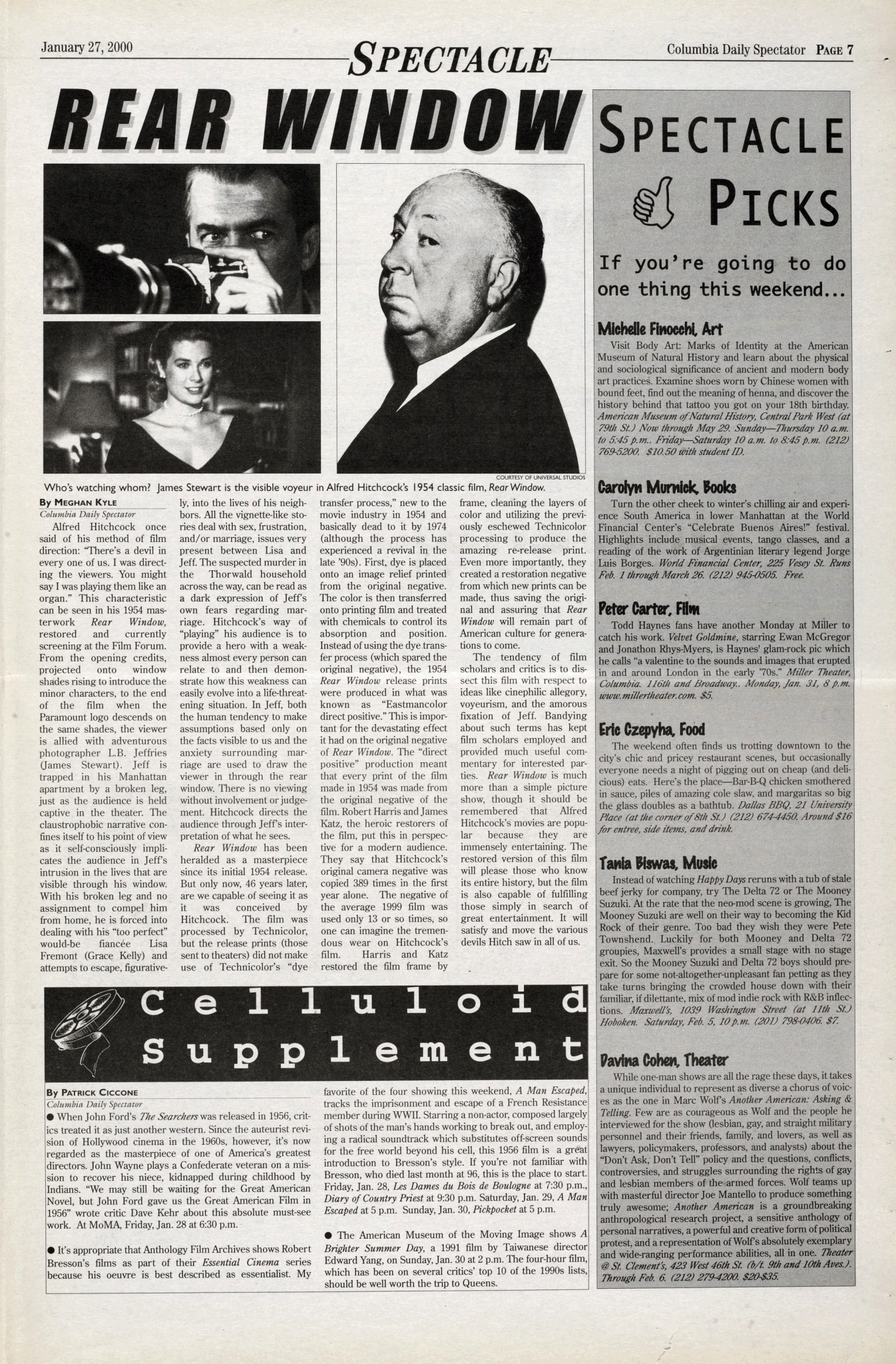Columbia Daily Spectator (27/Jan/2000) - Rear Window
Details
- article: Rear Window
- author(s): Meghan Kyle
- newspaper: Columbia Daily Spectator (27/Jan/2000)
- keywords: Alfred Hitchcock, Grace Kelly, James C. Katz, James Stewart, Paramount Pictures, Rear Window (1954), Robert A. Harris
Links
Article
Rear Window
Alfred Hitchcock once said of his method of film direction: "There's a devil in every one of us. I was directing the viewers. You might say I was playing them like an organ." This characteristic can be seen in his 1954 masterwork Rear Window, restored and currently screening at the Film Forum. From the opening credits, projected onto window shades rising to introduce the minor characters, to the end of the film when the Paramount logo descends on the same shades, the viewer is allied with adventurous photographer L.B. Jeffries (James Stewart). Jeff is trapped in his Manhattan apartment by a broken leg, just as the audience is held captive in the theater. The claustrophobic narrative confines itself to his point of view as it self-consciously implicates the audience in Jeff's intrusion in the lives that are visible through his window. With his broken leg and no assignment to compel him from home, he is forced into dealing with his "too perfect" would-be fiancée Lisa Fremont (Grace Kelly) and attempts to escape, figuratively, into the lives of his neighbors. All the vignette-like stories deal with sex, frustration, and/or marriage, issues very present between Lisa and Jeff. The suspected murder in the Thorwald household across the way, can be read as a dark expression of Jeff's own fears regarding marriage. Hitchcock's way of "playing" his audience is to provide a hero with a weakness almost every person can relate to and then demonstrate how this weakness can easily evolve into a life-threat-ening situation. In Jeff, both the human tendency to make assumptions based only on the facts visible to us and the anxiety surrounding marriage are used to draw the viewer in through the rear window. There is no viewing without involvement or judgement. Hitchcock directs the audience through Jeffs interpretation of what he sees.
Rear Window has been heralded as a masterpiece since its initial 1954 release. But only now, 46 years later, are we capable of seeing it as it was conceived by Hitchcock. The film was processed by Technicolor, but the release prints (those sent to theaters) did not make use of Technicolor's "dye transfer process," new to the movie industry in 1954 and basically dead to it by 1974 (although the process has experienced a revival in the late '90s). First, dye is placed onto an image relief printed from the original negative. The color is then transferred onto printing film and treated with chemicals to control its absorption and position. Instead of using the dye transfer process (which spared the original negative), the 1954 Rear Window release prints were produced in what was known as "Eastmancolor direct positive." This is important for the devastating effect it had on the original negative of Rear Window. The "direct positive" production meant that every print of the film made in 1954 was made from the original negative of the film. Robert Harris and James Katz, the heroic restorers of the film, put this in perspective for a modern audience. They say that Hitchcock's original camera negative was copied 389 times in the first year alone. The negative of the average 1999 film was used only 13 or so times, so one can imagine the tremendous wear on Hitchcock's film. Harris and Katz restored the film frame by frame, cleaning the layers of color and utilizing the previously eschewed Technicolor processing to produce the amazing re-release print. Even more importantly, they created a restoration negative from which new prints can be made, thus saving the original and assuring that Rear Window will remain part of American culture for generations to come.
The tendency of film scholars and critics is to dissect this film with respect to ideas like cinephilic allegory, voyeurism, and the amorous fixation of Jeff. Bandying about such terms has kept film scholars employed and provided much useful commentary for interested parties. Rear Window is much more than a simple picture show, though it should be remembered that Alfred Hitchcock's movies are popular because they are immensely entertaining. The restored version of this film will please those who know its entire history, but the film is also capable of fulfilling those simply in search of great entertainment. It will satisfy and move the various devils Hitch saw in all of us.

